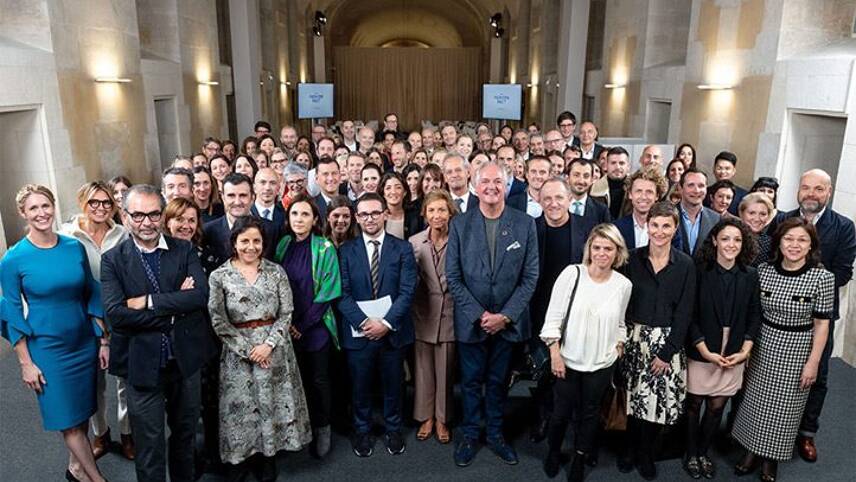Register for free and continue reading
Join our growing army of changemakers and get unlimited access to our premium content

Pictured: Representatives from the Fashion Pact's 56 member businesses and French President Emmanuel Macron meet in Paris. Image: Kering
Unveiled at the G7 summit this summer by Kering’s chairman and chief executive officer Francois-Henri Pinault, the Fashion Pact binds signatories to set science-based emissions reduction targets in line with a 1.5C trajectory – which, according to the Intergovernmental Panel on Climate Change (IPCC), will require most organisations to reach net-zero carbon status by 2050.
It additionally requires signatories to remove all single-use plastics from business-to-business and consumer-facing products and services by 2030 and to support new technologies aimed at minimising waterborne microplastic pollution – a key source of which is the laundering of synthetic fabrics which contain polymers, such as polyester and viscose.
Elsewhere in its text, the pact commits members to implement bi-annual external audits on sustainable sourcing; develop and launch measures to restore natural habitats; and do more to protect plant and animal species in supply chains, in line with upcoming science-based targets on biodiversity.
The Pact was initially signed by 32 fashion companies, including H&M Group, Inditex and Nike. This week saw a further 24 join the list, bringing the number of brands covered to 250.
These companies, which will now be required to produce their first progress reports in September 2020, are: Auchan Retail, Bally, Calzedonia Group, Celio, Damartex Group, Decathlon, El Corte Ingles, Eralda, Etam Group, Farfetch, Figaret, Gant, Geox, Groupe Beaumanoir, Groupe Eram, GTS Group, Kiabi, Lady Lawyer Fashion Archive, Mango, Nana Judy, Paul & Joe, Promod, Spartoo-Andre and The Visuality Corporation.
“Farfetch’s DNA is built on the idea of collaboration and working together for the benefit of the wider industry; we have ambitious plans to become the platform for good in luxury fashion,” Farfetch’s founder and chief executive Jose Neves said.
“Joining the Fashion Pact and the UN Fashion Industry Charter for Climate Action aligns to this ambition, whilst presenting a real opportunity to work with like-minded partners to help deliver fundamental change and preparing our industry for a positive tomorrow.”
Is green the new black?
The global fashion sector is believed to employ more than one in ten working-age people in the world and is, therefore, a key driver of economic growth.
But the industry also accounts for one-tenth of the world’s annual carbon emissions, 5% of global water use and is classed – alongside technology and agriculture – as one of the sectors with the highest risk of modern slavery in supply chains. Moreover, the scale of the sector has now reached a point where between 80-100 billion garments and 20 billion pairs of shoes are believed to be manufactured annually, with the equivalent of a bin lorry full of clothing being sent to landfill or incineration worldwide every minute.
In a bid to meet these large challenges with equally sizeable action, fashion brands and retailers are increasingly beginning to join collaborative initiatives as well as setting their own internal goals.
Such moves are being widely well-received by the general public. Selfridges’ most recent customer survey found that two-thirds of Gen Z shoppers are more concerned about climate change and other environmental and social issues than they were during summer 2018, with this rising concern having altered their spending habits in regards to fashion. Similarly, the Changing Markets Foundation’s recent fashion survey with the Clean Clothes Campaign found that three-quarters of Brits believe that clothing brands should be held responsible for the environmental impacts of their supply chains.
Sarah George


An equally important part of the solution to fashion industry’s pollution problem is behaviour change, i.e. getting people to wear what they buy and for longer. This might be helped if the world’s celebrity culture, especially the film and media world persuaded it’s ‘gliterarty’ that it is socially acceptable for them to wear the same outfit to more than one awards ceremony or gala ball. That might then send a powerful message to the masses that wearing what you buy until it wears out is part of the solution to environmental pollution.